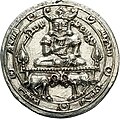File:Adud al-Dawla.jpg

Original file (1,431 × 1,425 pixels, file size: 375 KB, MIME type: image/jpeg)
| This is a file from the Wikimedia Commons. Information from its description page there is shown below. Commons is a freely licensed media file repository. You can help. |
Summary
| DescriptionAdud al-Dawla.jpg |
English: Buwayhids (Buyids). 'Adud al-Dawla Abu Shuja' Fanakhusraw. AH 367-372 / AD 977-983. Uniface Silver Medallion (60.7mm, 34.47 g). Cast and chased in high relief. Sasanian-style figure, wearing winged crown and an elaborate tunic with decorated sleeves, his legs crossed, holding goblet in his right hand, sitting cross-legged on wide, bench-like throne, decorated with pellets and with tear-drop shaped terminals; supporting the throne are two crouching ibexes, facing each other and butting heads.
To right (beginning in outer border, ending in field by bust): GDH APZWT - MLK 'N - MALK ('May the glory increase of the King of Kings') To left (beginning in outer border, ending in field by bust): ZIY DIR - SHA PANA (?) - HWSLA ('Long live Shah Fanna Khusraw') . Unpublished; cf. Miles, G.C., 'A portrait of the Buyid prince Rukn al-Dawlah,' ANS MN, 1964, pp. 283-293.. Tiny piercing above crown; minor surface marks and evidence of contemporary tooling in fields. Good VF. Of the highest rarity, apparently unpublished. There are clear similarities between the design of this beautiful medallion and a gold medal held in the Freer Gallery of Art, published by Mehdi Behrami more than seventy years ago in Archaeologica Orientalia in memoriam Ernst Herzfeld (New York, 1952), pp. 1-23. Miles reproduces Behrami's photograph in his article, and a more recent colour image of the obverse can be seen online at https://en.wikipedia.org/wiki/%27Adud_al-Dawla#/media/File:Adud_al-Dawla_medallion.jpg. While this gold medallion is anepigraphic, with two attendants to the left and right of the seated ruler where the Pahlawi legends are placed on this piece, its composition is otherwise remarkably similar. There are minor differences in the treatment of the throne, which lacks the tear-drop terminals seen on the present piece, and the gold medallion depicts lions beneath the throne rather than ibexes, but the depiction and attitude of the seated figure is virtually identical in both cases. The inscriptions on this medallion are, to use Miles's phrase, 'in the perverse way of most Pahlevi legends, difficult to decipher.' The suggested reading here is a tentative one, based largely on that proposed by Bahrami and Henning for the legends of another gold medallion of 'Adud al-Dawla, also illustrated by Bahrami and stated to be in a private collection in Tehran. Miles, who also discusses this piece, noted that while its authenticity had apparently been questioned, he himself felt that 'while it might perhaps be a modern copy of an original, but I doubt very much that the busts and the legends are fabrications.' The Pahlawi script is skilfully rendered on the present piece and the calligraphy itself is beautiful, but because the medallion has been cast and chased (it would not have been possible to create the magnificent high relief on this piece through striking), there is some blurring in the outer legends in particular where the engraver has not chased the lettering perfectly. The back of the medallion is entirely plain and was evidently smoothed to give a completely flat surface. It retains traces of copper, possibly where it was attached to another uniface plate to create a two-sided piece. What the other side might have looked like is a matter of conjecture, but there are reasons for thinking it may have been an Islamic legend, written in Arabic, as seen on the medallion of Rukn al-Dawla published by Miles, and also on a similar cast piece in silvered bronze which was later sold in London. Both of these pieces bear on one side a facing portrait of the Buwayhid ruler, flanked by Pahawi inscriptions, while the other side carries entirely conventional numismatic legends, naming the caliph and the Buwayhid ruler and with mint and date in the margin. Interestingly, the outer border on this medallion contains five stars-in-crescents, similar to the five crescents seen on the unique and spectacular gold Buwayhid 10-dinar medallion issued at al-Muhammadiya in AH 362 (Morton & Eden 73 (23 April 2015), lot 166). Thus while its superb relief and striking imagery contrast with the more austere appearance of the regular Buwayhid coinage, this beautiful medallion nevertheless fits within the same tradition. |
| Date | |
| Source | https://www.numisbids.com/n.php?p=lot&sid=6724&lot=222 |
| Author | www.numisbids.com |
Licensing
| This file is made available under the Creative Commons CC0 1.0 Universal Public Domain Dedication. | |
| The person who associated a work with this deed has dedicated the work to the public domain by waiving all of their rights to the work worldwide under copyright law, including all related and neighboring rights, to the extent allowed by law. You can copy, modify, distribute and perform the work, even for commercial purposes, all without asking permission.
http://creativecommons.org/publicdomain/zero/1.0/deed.enCC0Creative Commons Zero, Public Domain Dedicationfalsefalse |
Captions
Items portrayed in this file
depicts
27 April 2023
File history
Click on a date/time to view the file as it appeared at that time.
| Date/Time | Thumbnail | Dimensions | User | Comment | |
|---|---|---|---|---|---|
| current | 21:15, 12 November 2023 |  | 1,431 × 1,425 (375 KB) | AR VLD | Uploaded a work by www.numisbids.com from https://www.numisbids.com/n.php?p=lot&sid=6724&lot=222 with UploadWizard |
File usage
Global file usage
The following other wikis use this file:
- Usage on fa.wikipedia.org
